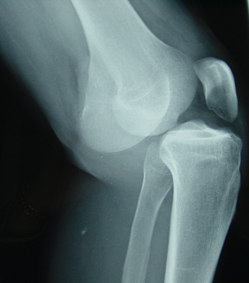 The knee joint is the joint between the femur (thigh bone) and the tibia (shin bone). It also articulates (rides against ) the patella (the knee cap). Because of its flat and potentially unstable shape, it is held together by a series of major ligaments and the surrounding soft tissues such as the muscles and tendons.
The knee joint is the joint between the femur (thigh bone) and the tibia (shin bone). It also articulates (rides against ) the patella (the knee cap). Because of its flat and potentially unstable shape, it is held together by a series of major ligaments and the surrounding soft tissues such as the muscles and tendons.
The knee contains two structures called the menisci. These lie between the tibia and femur joint surfaces and can simply be thought of as shock absorbers though their function is much more complex than this. Slightly confusingly the menisci are often known as the meniscal cartilages and as such the term leads to easy confusion with the articular cartilage (the actual weight bearing surface of the joint). Commonly people are often described as damaging their cartilage (by this it is meant that they have injured one of their menisci) rather than that they have damaged the articular surface.
The conditions affecting each part of the knee (from injuries to degenerate conditions) will be considered under separate headings in each section.
The knee is a frequently injured joint. The commonest injuries are often soft tissue injuries affecting the menisci and the ligaments or the articular cartilage surface of the knee. In injuries either of greater force or in people with weaker bone the injury may cause a fracture - a break in the bone.
Some fractures can be treated very simply and do not require any form of surgery whereas others are complex fractures requiring major surgery. In injuries where the bone does not fracture then the various ligaments may be ruptured or sprained. The degree of ligament damage may be related to the force that is put through the knee at the time of the injury. A low velocity or force injury may result in only one ligament being injured whereas a large force may result in multiple ligament injuries.
Sometimes a major injury may be associated with a series of other injuries in a well recognized combination. For example an anterior cruciate injury (ACL injury) may frequently occur in combination with a medial meniscal injury and a medial collateral ligament injury. Failure to recognize certain combinations of injury and only dealing with one of the injuries may be the reason that certain reconstructions fail. For example repair of an ACL injury but neglecting the so called posterolateral corner injury may result in early failure of the ACL reconstruction.
Degeneration of the knee is common as middle to late age is reached. There may be very good reasons for the degeneration starting at an earlier age (previous injury or operations such as removal of all the meniscus following injury). Operations to try to help remove the symptoms of degeneration may consist of attempts to realign the knee in younger people with premature degeneration or may consist of some form of joint replacement in older people.
Back to top